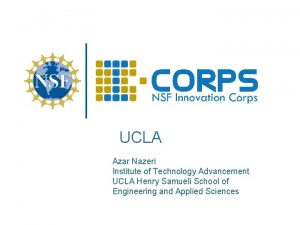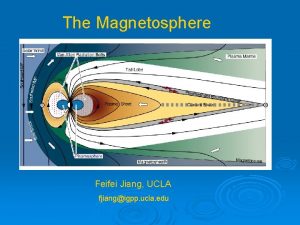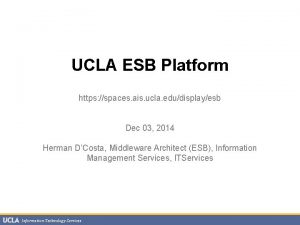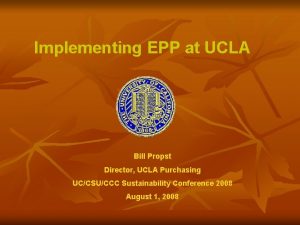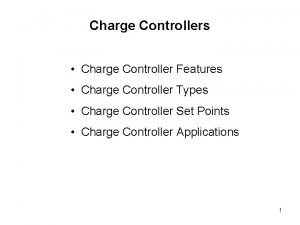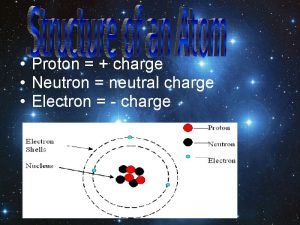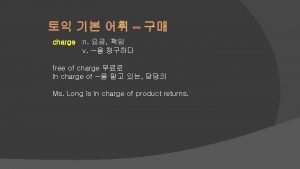The UCLA RF photoinjector at low charge and











- Slides: 11

The UCLA RF photoinjector at low charge and small spatial and temporal scales J. Maxson, D. Cesar, P. Musumeci UCLA Department of Physics and Astronomy HBB Workshop, Havana, Cuba March 29, 2016

Outline • The UCLA Pegasus photoinjector • Pegasus path to generating ultra-low transverse emittance: – Decreasing source size: oblique laser incidence – Concepts for decreasing source temperature • Diagnostics: TEM grid based full + slice phase space diganostic + High resolution YAG: Ce • Pegasus path to ultra small longitudinal emittances

The UCLA Pegasus Photoinejctor Gun Sol 1. Linac Spec. Sol. 2 Exp. Chamber Quads Deflector see D. Cesar’s talk Dielectric laser acceleration 400 nm V. aperture 1 mm BNL/SLAC/UCLA style 1. 6 cell gun, new brazeless design: D. Alesini et al. , PRSTAB 18, 092001 (2015) …ultra-low 6 D emittances required! see J. England’s talk

Generation of nm-scale emittances • Must reduce source size or source “temperature” • Source size: Utilize oblique (72 deg) incidence port on 1. 6 cell gun + strong final focus lens 175 mm lens Use 2 photon emission enhancement (in UV!) to adjust lens position -7 mm Beam Lase r in 25 mm stage UV on Virtual Cathode ~ 8 x 18 μm 0 mm 7 mm

Source temperature • Energy Fermi Sea ~ 250 me. V ! J. Maxson et al. , APL 106, 234102 (2015)

Measurement of nm-scale emittances • electron shadowgraph • High Transmission • 4 D Phase space information • Skew quadrupole • Nonlinearites • Sensitive to psf. Phase space “width” -> bar shadow blur Method benchmarked in: R. K. Li et al. , PRSTAB 15, 090702 (2012)

New ideas for extending the TEM grid method Shadowgraph Interpolated beamlet phase space (linear correlation removed) Emittance vs. charge Emittance vs. fraction 4. 125 mm 25 f. C 7. 25 mm Gulliford et al. APL 2015 : Beam phase space core contains information about cathode physics/thermal emittance. stronger transport invariant than 100% rms emittance. Invariance could break down with new cathode physics! 50 f. C More info: Single shot slice phase space: grids +slit +deflector. 7. 25 mm TEM Grid ~4. 5 ps XTCAV 200 f. C Preliminary analysis: need modeling of psf.

Ultrasmall bunch lengths & longitudinal emittance • X-band linearization cavity: Small energy spreads for UEM Frequency Shunt Impedance 9. 6 GHz 95 MOhms/m Quality Factor On-Axis Epeak RF Power(critical coupling) 9, 000 5. 3 MV/m ~9 k. W 20 f. C charge Sub-fs beam Or 20 e. V rms energy spread R. K. Li et al. , PRSTAB 15, 090702 (2012) Funded for STTR Phase II

How to detect ultra short beams? • At instrument resolution (limited by klystron forward power)

Summary • Source size reduction via oblique incidence • Approaching new limits in source temperature reduction • nm-scale emittance measurements – High spatial resolution solenoid scan – Phase space reconstruction with TEM grids • Ultrashort beams accessible with low charge and velocity bunching ~ 250 me. V !

Acknowledgements • UCLA Pegasus Laboratory group PI: Pietro Musumeci D. Cesar, E. Pyrez, E. Curry. Graduate students; A. Ody, G. Calmasini, Y. Sun undergraduates. • Collaborators: R. K. Li, D. Alesini, G. Andonian, F. Carbone, D. Filippetto, J. Luiten, J. B. Rosenzweig, J. Spence • Funding sources – Radiabeam Technologies. DE-FOA-0001164: SBIR/STTR FY 2015 Phase I award # 0000215429 – NSF grant #1415583














